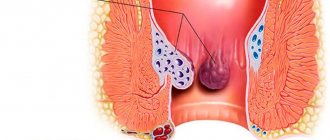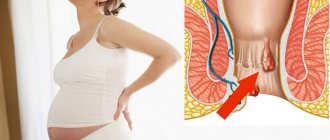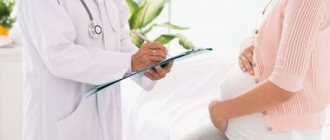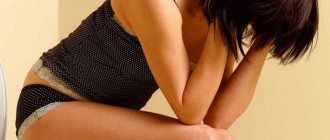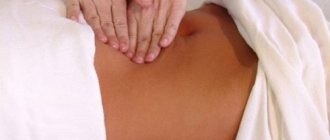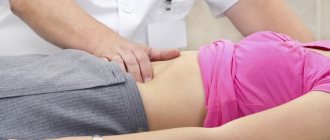Signs of the disease
How to properly treat hemorrhoids will depend on the stage of the disease. In the first stages of the lesion, it is not difficult to get rid of the pathology, but advanced forms cannot always be effectively treated without surgical intervention. Sometimes surgery is the only option.
There are 4 stages of hemorrhoids in men and women. Each has its own symptoms and is characterized by a specific condition of hemorrhoids.
- 1st stage of hemorrhoids. The full formation of nodes has not yet begun, but the patient is already complaining of discomfort in the anus and rectum. There is no pain, small lumps can only be diagnosed by a doctor using an instrumental examination of the rectal canal. The nodule does not appear outside yet.
- Stage 2 of hemorrhoids. As the disease progresses to the second stage, it may be complicated by prolapse of the cavernous nodes from the anus during bowel movements. The small nodule then returns to its place on its own, because the muscles did not have time to lose their normal tone.
- 3rd stage of hemorrhoids. The hemorrhoidal lump begins to come out of the rectum not only during bowel movements. This happens during sports or during exercise. There is pain and sometimes bleeding. If one lump has come out, you can return it to its place by applying effort, because the muscles can no longer perform this action on their own.
- Stage 4 hemorrhoids. The hemorrhoid comes out even with slight strain - coughing, defecation, laughter, movement. In addition to intense pain and constant bleeding, vascular strangulation and thrombosis develop.
Stages
It can be difficult to predict the course of hemorrhoids, despite the high level of information in medicine about this disease, so the patient is recommended to gain knowledge of how to behave correctly at different stages of the lesion.
What kind of disease is this?
Due to stagnant processes, the veins in the rectum expand. If hemorrhoids come out, you need to eliminate the provoking factors:
- Alcohol abuse.
- Physical inactivity.
- Anal sex.
- Lifting heavy objects.
- Poor nutrition.
- Disruption of the gastrointestinal tract.
Pregnancy and childbirth also increase the likelihood of developing the disease.
The initial symptoms of hemorrhoids may not cause concern to the patient:
- feeling of discomfort during bowel movements;
- anal itching.
Bloody stool is the first warning sign. Bloody discharge can be detected after a bowel movement. The act of defecation is accompanied by pain. The nodes fall out of the rectum.
Hemorrhoids are a disease affecting the male and female parts of the population.
Each stage of hemorrhoids has its own clinical picture:
- At the first stage, hemorrhoidal cones do not extend beyond the rectum. Due to their small size, they are practically not felt, but make defecation difficult. Itching and burning increase discomfort. Therapy consists of the use of ointments, tablets and suppositories: “Anestezol”, “Relief”, “Gepatrombin G”. After using medications, there is a decrease in hemorrhoids and the severity of pain. You can also use a folk remedy for hemorrhoids - ice, sea buckthorn, potato suppositories, decoctions of medicinal herbs, propolis.
- In the second stage, health problems become more noticeable. The nodes fill with blood. The pain intensifies. The appearance of prolapsed cones is possible during bowel movements. In addition to conservative medicine, you can prescribe lotions with decoctions of sage, calendula, and chamomile. They help eliminate inflammation of hemorrhoids. To reduce itching, you can place the affected area in a bowl of cool water. In the absence of a therapeutic effect, minimally invasive procedures are resorted to.
- In the third stage, blood appears in the stool. It is characterized by the loss of internal nodes even with minor physical exertion. They do not correct themselves. The patient experiences severe pain and anal itching. The drugs “Eskuzan”, “Detralex”, “Litovit” stop inflammation, reduce swelling, and strengthen the walls of the veins. At this stage, minimally invasive treatment methods are effective, the help of which is to eliminate the nodes with minimal tissue trauma. The recovery period takes little time.
- The fourth stage is the advanced form. The bumps fall out all the time. Defecation and movement are accompanied by severe pain. Infringement of cones or thrombosis is observed. Treatment consists of surgery. Conservative medicine is ineffective. After surgery, recovery takes a long time.
Read also
How can you relieve swelling from hemorrhoids?
You can begin therapeutic measures only after consulting a doctor. He will determine the stage of the disease and correctly prescribe a course of therapy.
With a long course of the disease, the patient experiences a decrease in the elasticity of blood vessels in the lesion.
Reasons for the appearance of external nodes
The main reason for the formation of hemorrhoids is venous dysfunction. When the blood flow is disrupted, their walls are subject to deformation, and nodes are formed that tend to increase in size.
It is believed that the development of hemorrhoids requires a predisposition, which involves weakness of the vein walls. In fact, this is a common disorder, since external hemorrhoids, according to medical data, affect more than half of the world's inhabitants.
But statistics cannot establish an exact figure, because people do not always go to the doctor because of the sensitivity of the problem; they often try to treat hemorrhoids on their own. Hemorrhoids may subside for a while, and then recur with renewed vigor.
Causes of exacerbations of external hemorrhoids include:
- Disturbances in the gastrointestinal tract. These include constipation, because in this condition defecation lasts longer,
- Constant diarrhea is also a cause of hemorrhoids,
- Abuse of enemas
- Lifting weights. Typically, this problem applies to male representatives whose work involves constant physical activity,
- Pregnancy in women is a common cause of hemorrhoids. This happens due to hormonal imbalances and stress on blood vessels during pregnancy. In addition, natural childbirth is always accompanied by pushing, which will lead to the hemorrhoidal node falling out of the anus,
- Poor nutrition – constant consumption of spicy and fried foods, spices, canned food, marinades, refusal of fresh fruits and vegetables,
- Sedentary work - lack of physical activity leads to stagnation in the veins of the pelvis and, as a consequence, to the development of hemorrhoids.
One of the reasons
Usually the disease develops already in a person’s conscious age. People aged 30–40 years are most susceptible to hemorrhoids.
A node comes out during pregnancy: what to do
Prolapse of the venous plexuses can occur in the early stages of pregnancy. But most often this pathological condition is detected in the last months. This is due to the fact that the enlarging uterus disrupts the blood supply to the vessels.
The lump may burst and then bleeding will begin.
If the nodes fall out, a pregnant woman should:
- Contact your doctor immediately. If a woman does not do this, she risks complications during and after childbirth.
- To eliminate pain, take medications that contain lidocaine or anesthesin (in the first trimester). If the disease takes you by surprise in the second trimester, then you can use the drug Hepatrombin G. And from the third trimester you can take Detralex tablets.
Any medications for hemorrhoids during pregnancy should be taken only as prescribed by a doctor.
How can a doctor help?
When the hemorrhoids come out, the proctologist can apply minimally invasive therapy methods to the pregnant woman:
- Sclerotherapy.
- Alloying with latex rings.
- Laser exposure.
- Cauterization using infrared radiation.
These methods are the most effective in treating prolapsed hemorrhoids in pregnant women. Therefore, at the first signs of deterioration in health, contact a specialist. This is the first priority for a pregnant woman.
Traditional treatment for hemorrhoid prolapse
What should a pregnant woman do before visiting a doctor?
To alleviate the condition, a pregnant woman must adhere to the following rules:
- Maintain hygiene of the anal area.
- Drink enough liquid.
- Try to move a little.
- Eat vegetables, fruits, oatmeal.
- Adjust the chair.
- Perform a cleansing enema.
- If necessary, take laxatives.
What are the dangers of prolapsed nodes during pregnancy?
If the nodes bleed, the woman becomes anemic. And a lack of hemoglobin can lead to delays in the growth and development of the fetus.
If an infection gets into the prolapsed node, a purulent-inflammatory process appears. It leads to the fact that toxins and harmful substances will be absorbed into the blood, reaching the fetus. The child will be infected while still in the womb.
Considering the consequences that external hemorrhoids can lead to, women should contact specialists at the first symptoms of the disease.
If the nodes were not corrected and labor began
Childbirth and hemorrhoids are not uncommon. More often, the disease appears after childbirth. If there is an external problem, giving birth to a child is not contraindicated, but pathology can complicate the birth process. Caesarean section is allowed only if there is heavy bleeding. In other cases, a woman should prepare for a painful and lengthy natural birth. After the baby is born, the fallen nodes are reset by obstetricians; sometimes the help of a proctologist may be required.
It is very important not to confuse thrombosis of external hemorrhoids with prolapse of internal nodes.
Hemorrhoids came out: what to do? First aid
When hemorrhoids suddenly appear, urgent measures should be taken. The following actions will help prevent complications and alleviate the condition during exacerbation:
- You need to lie down in bed, turn on your side and try not to move, calm down and relax. Nervous tension increases pressure in the pelvic area and worsens the condition,
- You should not push when you have the urge to defecate. Straining greatly increases the pressure in the pelvic area, worsening the condition - this causes the hemorrhoids to become pinched and may fall out, sometimes bleeding,
- You can do a therapeutic enema to cleanse the intestines, heal wounds in the rectum,
- Use suppositories that will relieve pain and help stop bleeding as it develops,
- For constipation, use mild laxatives, but with caution, since severe diarrhea will only worsen the condition,
- Observe personal hygiene rules. To prevent the risk of secondary infection during an exacerbation, it is important to wash yourself after each bowel movement with cool running water. You should also use soft toilet paper and napkins after using the toilet. If necessary, use them to remove the fallen knot.
- During the period of exacerbation, you need to give up physical activity and sports. Walking should be slow and only for short distances. It is forbidden to lift weights exceeding 2 kg.
After pain relief, you need to contact a proctologist. He will identify the type of hemorrhoids, the stage of the lesion, and give recommendations on further behavior and treatment of the disease.
Danger of knots falling out
It is impossible not to treat protruding hemorrhoids, since this disease is not only accompanied by discomfort and pain, but can also lead to a number of complications.
The most common pathological process against the background of advanced hemorrhoids is the destruction of tissue in the intestinal area. When feces pass through them, the likelihood of infection and infection increases significantly. Also, the lack of timely treatment can lead to the following consequences:
- development of the inflammatory process in organs located near the intestines;
- dysfunction of the sphincter muscles;
- involuntary leakage of feces;
- tissue necrosis on the intestinal walls;
- vein thrombosis;
- the appearance of purulent accumulations in the rectum;
- anal fissures.
In addition, hemorrhoids in the last phases of development are accompanied by constant bleeding, which often causes anemia. Therefore, if hemorrhoids appear after childbirth or during pregnancy, the woman should definitely seek help from a specialist.
Recipes, menus and diet products
Treatment tactics at different stages
In the first stages of hemorrhoids, it is important not to delay a visit to a specialist who will explain how to treat the disease. He will identify the form and stage of hemorrhoids and prescribe effective drug treatment.
Most often, at the initial stage of the disease, local drugs are used - suppositories and ointments. The most effective are:
Troxevasin
If venous insufficiency is detected, the use of venotonics is prescribed. They normalize the tone in the veins, strengthen blood vessels, and eliminate congestion in the pelvic area. Effective venotonics include:
- "Detralex"
- "Venarus"
- "Troxevasin".
Self-use of drugs is prohibited due to an extensive list of contraindications.
Drug therapy is often supplemented with traditional medicine. They are made independently at home from the simplest products:
- candles made from potato pulp,
- candles with honey and propolis,
- baths with decoctions of medicinal plants,
- microenemas with decoctions of medicinal plants,
- compresses with sea buckthorn oil.
If the disease has not yet become chronic, then hemorrhoids are curable, and positive prognoses of recovery and the ability to forget about the disease once and for all remain.
Stage 2
Even at the second stage of the disease, the situation remains fixable. At the same time, there is an increase in the size of the hemorrhoids; they increasingly fall out, but are still able to set themselves. Blood can appear not only during defecation. She smears her underwear, and the discomfort becomes stronger. Sclerotherapy, laser exposure and other procedures are added to the complex treatment carried out at the first stage of the lesion.
Doctors prescribe the use of Escusan drops, injections, and ointments to relieve pain. Baths, creams and cold compresses are suitable to stop bleeding.
Aescusan
Stage 3
At the 3rd stage of hemorrhoid progression, the lump falls out not only during defecation. This happens during physical activity. At the same time, pain and bleeding appear, and the knot can be straightened only with effort, because the muscles cannot perform this task on their own.
Over time, the pathology progresses, and foci of inflammation form in the affected areas. Bleeding becomes more frequent and severe.
This stage is characterized by constant prolapse of the node. If they come out, there is a risk of strangulation and thrombosis. It is best to consult a specialist, since incorrect manipulations will only complicate the condition. The general rules for implementing reduction are as follows:
- Wash your hands thoroughly with soap, wear sterile medical gloves to prevent infection,
- Apply “Heparin ointment”, “Troxevasin” to the node to reduce the intensity of pain,
- Take a special position - tilt the body forward, spread the muscles of the buttocks, feel the nodule and press it into the anus with your finger,
- Squeeze your buttocks, tighten the muscles of the anus so that the internal hemorrhoid does not pop out again,
- Lie down comfortably, preferably on your side, lie there for half an hour.
There is no need to make any effort when performing the reduction. If you cannot do this, you need to stop trying and seek help from a medical institution.
Important! As a rule, at the 3rd stage of hemorrhoids, even complex treatment with the use of venotonic tablets and the use of local drugs does not allow achieving positive dynamics. This happens because the mucosal muscles are already too weakened.
In this situation, proctologists most often recommend minimally invasive methods of treating hemorrhoids. The most popular minimally invasive procedures include:
- ligation using latex rings,
- cryodestruction,
- disarterization,
- sclerosis,
- photocoagulation and laser coagulation.
The listed low-traumatic methods do not require general anesthesia; sometimes local anesthesia is performed. The operation is carried out quickly and allows the patient to return to normal life.
Stage 4
It is characterized by constant popping out of nodes and frequent bleeding due to severe damage to the rectal mucosa. This is the most advanced and severe course of hemorrhoids; serious measures are needed to carry out effective treatment.
Due to the effect of hemorrhoids on the body, a person develops other pathologies - necrosis, thrombosis, prolapse. Treatment involves only surgery using laser coagulation and radio waves.
How are stage 2 hemorrhoids treated?
With hemorrhoids in the second stage, there is a significant increase in hemorrhoids, in addition, the inflamed formations are increasingly found on the outside. And if hemorrhoids come out, then it is by no means asymptomatic - pain and bleeding will definitely bother you.
At this stage of the development of the disease, the muscles themselves are still capable of returning the displaced nodule to its place, but the condition requires mandatory medical attention. Treatment once the disease begins to progress is much more difficult.
In this case, you definitely need to see a specialist who will prescribe effective treatment. It includes the same drugs that are recommended for the treatment of stage 1 of the disease, but the therapy is supplemented with other drugs, for example, those with a laxative effect (if the patient is bothered by frequent constipation).
Difficulty defecating worsens the course of the disease, leading to the appearance of anal fissures and the development of complications
If the pain is significant, the specialist will prescribe an anesthetic or non-narcotic analgesic.
If the hemorrhoidal lump is not outside, but inside, that is, internal hemorrhoids develop, then it is better to use topical agents in the form of ointments or suppositories to reduce pain:
- Ultraproct;
- Gepasolone;
- Aurobin;
- Proctoglivenol;
- Nefluan et al.
Exacerbation of the disease in 80% of cases provokes the development of hemorrhoidal thrombosis.
Exacerbation of the disease in 80% of cases provokes the development of hemorrhoidal thrombosis
Lumps filled with bloody or purulent exudate may remain inside or fall out. Thrombosis is accompanied by bleeding, swelling and severe pain. How to treat this complication?
First of all, it is recommended to use local anticoagulants, the best of which are Troxevasin and Heparin ointments. They can also be used in combination with water-soluble agents: Levomekol, Levosin, Manifid.
You can tell that therapy is helping by the fact that the pain subsides, and the bleeding becomes more scanty and stops. If this does not happen and the bleeding does not stop, then treatment includes local medications, which, when absorbed, form a film of fibrin:
More article:How to treat postpartum hemorrhoids
- Beriplast;
- Androxon;
- Tachycombe;
- Spongostan.
In addition to the means of official medicine, folk methods can be used at these stages. In addition, many of them help if hemorrhoids come out during pregnancy or childbirth. After all, medications naturally have fewer side effects, but before using them, you need to consult a proctologist.
Traditional methods of treatment
Hemorrhoids can be treated using traditional medicine methods, provided that the disease is at stage 1 or 2 of development. Baths with medicinal herbs help stop the inflammatory process. They should be done after each bowel movement to prevent infection and eliminate unpleasant symptoms. The most effective plants include:
- calendula,
- chamomile,
- burdock root,
- yarrow,
- sage,
- bird knotweed.
To make such a bath, you need to follow the recipe: pour a tablespoon of the plant with a glass of boiling water and leave for 20 minutes or a little longer. The temperature of the finished broth should not be more than 35 degrees. Make baths for 10 – 15 minutes.
Birch tar treatment has good reviews. Add a tablespoon of tar to 2 liters of water. It is dissolved in boiling water, then the solution is cooled to a comfortable temperature, and baths and lotions are also made.
Burdock root
Herbal tinctures and decoctions for oral administration
When a hemorrhoidal cone falls out, then most likely the disease is already in the second or third stage of development. Good traditional medicine at this stage are:
Compresses and lotions
Hemorrhoids are always accompanied by burning and itching; the anus area may itch and hurt. Lotions made from herbal decoctions of the following plants help to alleviate the condition:
- carrot tops,
- St. John's wort with chamomile,
- common mullein.
Important! Fresh potatoes, sea buckthorn oil, aloe juice, and a solution with potassium permanganate also have active medicinal ingredients.
When a hemorrhoid node subsides, you can apply a compress with beeswax or propolis tincture to it. At stage 2, there is still no need to reduce the nodes, and with adequate therapy, the disease can be cured completely.
Carrot tops
What are hemorrhoids
All people have hemorrhoids, they are part of the normal circulatory system.
They are Hemorrhoids under the rectal mucosa and a layer of elastic tissue, so they are usually invisible. As long as the blood flow in the pelvic vessels is normal, nothing happens. But if something interferes with the outflow of blood, it accumulates in the nodes, stretches them and makes them look like blue sacs. The elastic tissue that should support the intestinal wall gradually breaks down and becomes thinner. Nodes can be seen through it, they can bleed and become inflamed, and move downwards. This is hemorrhoids Clinical guidelines for the diagnosis and treatment of adult patients with acute and chronic hemorrhoids.
If changes occur in the nodes of the lower intestine, it is internal hemorrhoids hemorrhoids. If located under the skin of the anus - external. Sometimes a combined form occurs when two types of nodes enlarge.
Hemorrhoids are very common Definition & Facts of Hemorrhoids among both men and women. According to statistics, three out of four people will sooner or later develop symptoms of the disease.
How to fix it?
Before repositioning the nodes, perform hygienic procedures and reduce swelling with medications or an ice compress.
In the picture: reduction of hemorrhoids
After the pain has subsided, put on rubber medical gloves, get on all fours, spread the buttocks with one hand, and with the other, after dipping your finger in Vaseline, insert the knot into the rectum, pushing it through the anal canal.
If it is left in the anal canal, it may fall out again. After the knot is set, you need to tighten the sphincter and lie down for about 30 minutes.
Under no circumstances should nodes be reset if there are signs of thrombosis or if they are strangulated.
Choice of medical products
At stage 1, hemorrhoids respond well to treatment with conservative methods. The use of suppositories, medicinal baths and lotions will allow you to cure stage 1-2 hemorrhoids at home.
The third stage requires longer treatment and most often requires surgical intervention. During treatment, it is recommended to use tablets to improve the strength of blood vessels and the venous wall.
It is useless to smear hemorrhoids at the 4th stage with the most expensive drugs. At best, home methods will help alleviate the condition.
Stage 4 requires mandatory surgery, and the sooner it is performed, the lower the risk of complications after this procedure.
How to relieve hemorrhoid symptoms
At an early stage, your doctor will likely recommend simple methods to help relieve hemorrhoid symptoms. It is unlikely that the nodes will be returned to their previous size. But the person will have time to prepare for more serious treatment.
Diet
Hemorrhoids are caused by chronic constipation, when a person has a bowel movement every 3 days or less. Hard stool hurts the mucous membrane and makes you strain hard in the toilet. Therefore, it is important to make the intestines work normally in order to go to the toilet 1-2 times Chronic constipation: ideas, pathogenesis, diagnosis, new treatment options per day.
Proctologists recommend Hemorrhoids for hemorrhoids to eat more vegetables and fruits with coarse fiber or use special Hemorrhoids supplements with it. The latter should be introduced into the diet gradually and do not forget to drink 8-10 glasses of water.
Baths
They should be done daily for a week for 10–15 minutes. Hemorrhoids should be filled with ordinary warm water or a decoction of medicinal plants into a small basin. For example, take 1 tablespoon of chamomile or calendula flowers, brew them with a glass of boiling water, and dilute the resulting infusion in 3-4 liters of warm water. Medicinal herbs help Chamomile flowers (Chamomillae recutitae flores) reduce swelling and inflammation around the nodes.
Symptomatic drugs
Your doctor may prescribe medications that will relieve the symptoms of hemorrhoids. Hemorrhoids. The following types of drugs are effective:
- Painkillers. A group of non-steroidal anti-inflammatory drugs is usually used.
- Phlebotonics Phlebotonics for haemorrhoids. They help improve vein tone and blood flow.
- Hemostatic. Needed to stop minor bleeding.
Laxatives
If diet does not help relieve constipation, your doctor may prescribe laxatives. They soften stool and speed up their elimination. Usually the drugs are taken for 1–2 days. If you take them longer, the intestines get used to Chronic constipation syndrome in patients who abuse irritating laxatives to work only with constant stimulation, and the body loses many vitamins, minerals and nutrients.
Candles and ointment
Medicines in the form of suppositories or ointments help to quickly get rid of the symptoms of hemorrhoids. They may contain painkillers, hormones, and hemostatic components. Therefore, after the first use, pain and itching go away, and going to the toilet becomes easier.
But candles don't help me. Why? It must be remembered that suppositories remove Necessary and unnecessary treatment options for hemorrhoids symptoms of hemorrhoids, but do not affect the node itself. It stops hurting and doesn’t bleed, but if you have an unhealthy diet, constipation, or during pregnancy, it will come back to haunt you.
